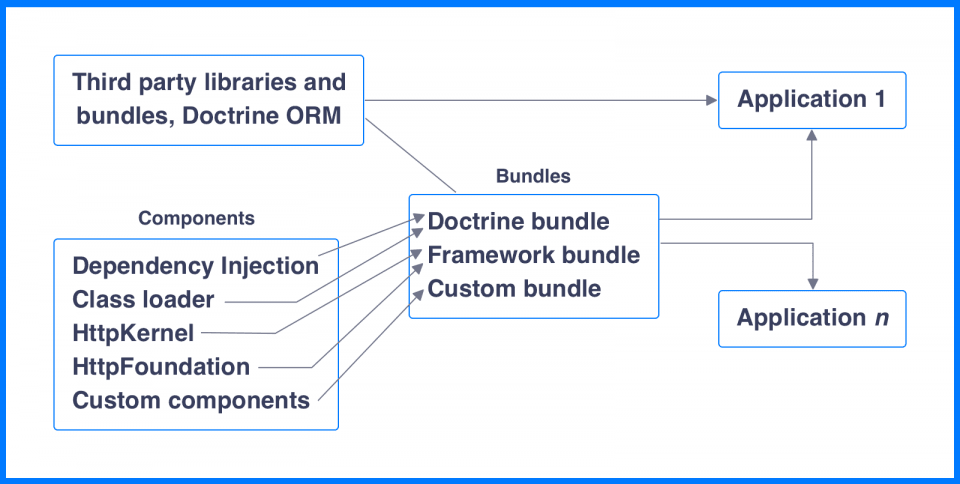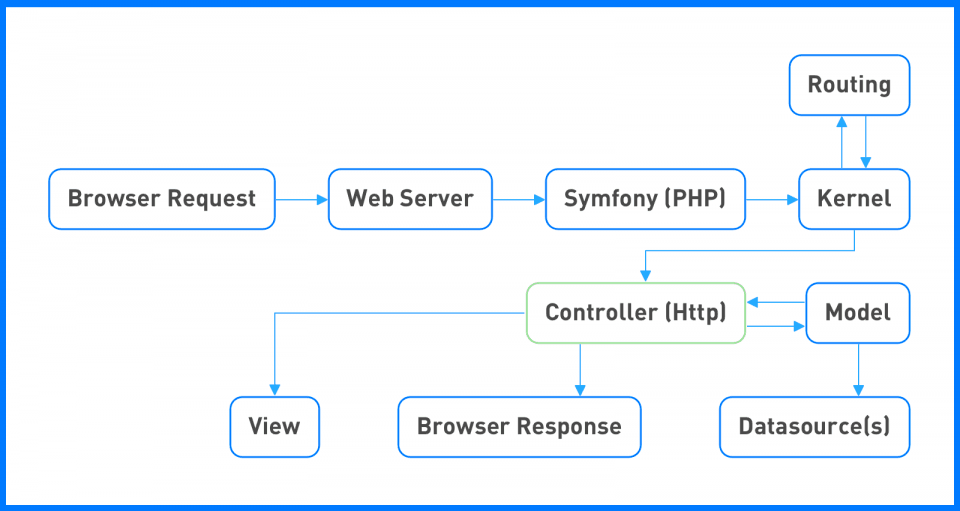Symfony is an ASCII text file PHP framework designed for web applications. This article will hash out how Symfony came into beingness, polar components, computer architecture, work flow, base steps for installation, and more.
IT has established itself as a foundation for entanglement services. Symfony contains reusable PHP libraries and components. Projects like Laravel and Drupal use Symfony components in their applications.
Symfony was developed to thin out creation and maintenance time for World Wide Web applications and avoid repetitive tasks. It is greatly influenced and glorious by the Spring model.
Account of Symfony
Symfony was discharged by SensioLabs and published on October 18, 2005, as available software. It was released under the MIT license. Nevertheless, a more stable first version was free in 2007, yet, it wasn't as promising every bit version 2.0. Nonetheless, developers were finding major issues with the upgrade and backward compatibility. The best and most promising version was 2.3, which had good stability and features. The upgrades after that, 2.4, 2.5, 2.6, were non so spectacular, and each the further releases were backward compatible. The current version is 5.2, which has few significant features like Counterfeit-localization, 24-bit colors on the solace, TranslatableMessage objects, support for PHP 8 attributes/annotations, and more.
Features
As we mentioned before, the of import aim of Symfony is to optimize network applications. Symfony frameworks have the following unique features:
- MVC based micro-framework (Model-Watch-Controller)
- Extremely performant PHP framework
- Reusable components that are decoupled
- Error logging and session management features
- Compromising URI routing
- Vibrant, active community
- Highly full-grown Twig guide engine
- Extensible, soundly code readability
- Support for multiple database platforms
Symfony Architecture
The architecture is simple and consists of components and bundles that are reusable.
Components provide single specialized functionality. For example, the HTTP component, cache component part, filesystem component, etc. These are nil but standalone PHP libraries.
Bundles are like plugins and are easier to create and consumption. A packet can wont many Symfony components and provide many an features. A Symfony core network-fabric itself is a bundle (FrameworkBundle).
Components can access whatever number of bundles. The common bundles utilised in the framework are FrameworkBundle, FrameworkExtraBundle, DoctrineBundle. Other than that, we can have impost bundles and doctrine bundles.
The Symfony application can access components and bundles independently. The below diagram represents the complete relationship 'tween components and bundles:

Differently FrameworkBundle, the following components need about mention every bit below:
HttpKernel
This component provides the building blocks compulsory to create fast and elastic HTTP-based applications. Information technology can embody installed victimization the command:
$ composer require symfony/HTTP-meat
(Don't worry if you don't realize the in a higher place right now, we will handle what this is in the future section!)
Approximately projects that used the HttpKernel ingredient are Drupal, OroCRM, Lumen, Thelia, Sulu, etc. The kernel internally defines a work flow that starts with a request and ends in a response. It resolves the controller, arguments and gets the reception using the manage() method. Events drive all the steps in the HttpKernel workflow.
HttpFoundation
The HttpFoundation factor is responsible for adding the object-familiarized layer to the HTTP specification. The round variables that are part of every HTTP request, same, GET, Emily Post, COOKIE, SESSION, etc., are attentive in an object-homeward layer. To install this component, give the command atomic number 3:
$ composer require symfony/HTTP-foundation
DoctrineBundle
To know about DoctrineBundle, we need to eff what Philosophical system is.
Philosophy is a visualize or put away of PHP libraries that provide persistent services. It contains ORM (Object-Relational Mapper) and database abstraction layer (DBAL). It uses the Philosophy Enquiry Language (DQL), the object-oriented counterpart of SQL, to write database queries. With Philosophical system, there is no more need to stack away and maintain complex XML database schemas.
The DoctrineBundle integrates the ORM and DBAL layers into Symfony applications. You too father a set of comfort commands, configuration options, and web debug toolbar aggregator. To install the megabucks, typewrite:
$ composer require ism/doctrine-bundle
To get a database-specific bundle, for instance, if you desire DoctrineMongoDBBundle, you should add the particularised bundle to the composer.json file:
"deman": {
"doctrine/mongodb-odm-sheaf": "^3.0"
},
then install the dependencies victimization the update command from the compose.json single file's directory (location):
$ php composer.phar update doctrine/mongodb-odm-bundle
How to Download and Install Symfony
To install Symfony on your political machine, you should have PHP 5.4 or later. Apart from this, it is good to have a web-host like WAMP or Microsoft IIS for Windows, MAMP for Mac, LAMP for Linux, or XAMP/Nginx (Multi-program).
You can directly install the installer through command-bloodline using the pursuing commands:
$mkdir -p /usr/local/bin
$curlicue -LsS https://symfony.com/installer -o /usr/local anesthetic/bin/symfony
$chmod a+x /usr/local/bin/symphony orchestra
Once we have installed the installer, we can buoy create a new application:
symfony new <our_app_name>
Upon performance of this command, Symfony will represent downloaded on your scheme, and the see will be created with its directory 'first app/.'
To run the app, we need to kickoff the host:
cd <our_app_name>
PHP bin/console server:run
To see if the installation is booming, open the browser and attend localhost:8080. You should see a welcome content:

Once the fabric is installed, you can install the required components and bundles, As shown in the previous section!
Simple Symfony Work flow
The Symfony framework provides all the features required by an endeavor application. Here is a typical workflow of how a Symfony web application works:

A typical workflow consists of the following steps:
- The user makes an covering quest via the browser, using the HTTP protocol, i.e., http://xyz.com
- Successively, the browser passes the request to a entanglement server like Apache, WebSphere, etc.
- The server then forwards the user call for to the underlying PHP layer. The PHP layer, in turn, redirects it to the Symfony vane framework.
- The core component HttpKernel resolves the controller (we proverb this in the architecture) of the request. It uses the routing component to forward the request to the target request controller.
- The primary business logic is executed in the controller bed.
- Next, the DoctrineORM comes into the picture, through which the controller interacts with the Model. The DoctrineORM is responsible for copulative to the data source.
- At one time the process is complete, the controller generates a response on its have or creates it through the Perspective engine. View engine is nothing but a ingredient responsible converting the response into an HTML format.
- The reception is dispatched back to the webserver. The web server then transfers the response to the user (browser).
Symfony Framework Advantages
Advantages of Symfony are:
- Fast-Paced Development : Since Symfony is a portion-based framework, it can be easily installed and used. This makes development faster and efficient and helps developers ramp up applications quickly.
- Flexibility : With features like dependency Injection (DI) and event dispatching, Symfony makes it easy for developers to create even complex applications with the highest level of configuration, giving flexibility to the code.
- Extensibility : Since everything is a packet and adds unique functionality, developers can recycle bundles or add to the framework. There is no need to qualify the fabric; just the package can be configured to suit specific project requirements.
- Constancy : After the initial glitches, the new versions of Symfony have been quite stable and sustainable. They are besides well-matched with public APIs.
- Comfort of Development : Developers do not motive to worry about minor functionalities and stress on their business system of logic while the framework takes care of the core functionalities. Symfony works for small to big projects because of its component and bundle-supported computer architecture. Web debugging toolbars help address different issues in the early stage of development, ensuring high-select deliverables.
Symfony Components
Symfony is easy to learn because it consists of components and bundles, and if you know close to the substance components and bundles, you can easily create new applications. Few important components are:
1. Finder
It provides classes to seek files and directories in the mentioned path quickly by iterating over the files.
2. Filesystem
Provides commands to perform radical file trading operations equivalent creating a register or a folder, checking if a file exists, etc.
3. ClassLoader
Provides the implementation for class loader standards of PSR-0 and PSR-4. It also does auto loading of classes.
4. DependencyInjection
Provides containers to treat dependencies. The framework uses this component extensively victimisation the divine service container.
5. EventDispatcher
Provides result-based PHP programming. Objects send away communicate with each new by dispatching and listening to events.
6. Serializer
Through Serializer, we tin can convince PHP objects into different formats like JSON, binary, XML, etc., and convert them back to PHP objects without whatsoever loss of data.
7. ExpressionLanguage
Provides an expression engine that makes code neater and smaller. ExpressionLanguage consists of two ways for working with expressions: evaluation (the expression is evaluated without compilation to PHP) and compilation (the manifestation is compiled and then that information technology can represent cached and so evaluated). It supports many syntaxes like literals, objects, operators, functions, arrays, etc.
8. Workflow
Allows for advanced PHP programming by giving hi-tech tools for processing limited state machines.
9. HttpFoundation
Provides an object-destined layer to the HTTP petition and reply objects supplied by default by PHP.
10. Form
Enables easy kind creation in a World Wide Web application
11. HttpKernel
Takes care of the entire request-answer cognitive process of a web coating. IT is the main component of Symfony architecture.
12. Routing
Routing determines the part of the application program that should handgrip a particular request. It maps the request in hand to a set of pre-defined configuration variables.
There are many much components of Symfony, and you can clave the functionary Symfony website to check them all.
Symfony Bundle
A bundle is a collection of files and folders arranged in a particular structure. The arrangement is made such that ninefold applications give the axe reuse the bundles. The main Symfony application is packaged every bit a bunch up and is known as the AppBundle. Some other examples of a bundle can be AdminBundle (an admin internet site), HelloMobileBundle (a hello rotatable app), etc.
The bundle consists of the following:
- Restrainer : All the controllers are ordered in the comptroller brochure
- Dependency Injection : Altogether the files correlate DI and configuration go here
- Resources/config : for bundle related configurations
- Resources/public : CSS, JS, images, etc., related to the bundle go here.
- Resources/prospect : to store all the view templates related to the pile
- Tests : All the bundle unit tests are stored therein folder
You can easy customize a set out of some third-political party bundle that you want to use for your application. Check the Symfony bundle overriding for more details.
Further Recital
We have blanketed enough for you to get started with Symfony. The clause should have generated good interest in Symfony, and you would be able to follow the Symfony framework's basic concepts. To learn Symfony, you should know the PHP framework. To learn Symfony, go over our complete list of courses and tutorials (just about of them are completely free!!). You can also study some top books the like A twelvemonth with Symfony or The expressed guide to Symfony.
DOWNLOAD HERE
Symfony Framework - A Complete Beginner's Guide Free Download
Posted by: sledgehimeb1991.blogspot.com

0 Comments